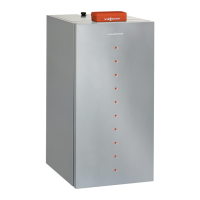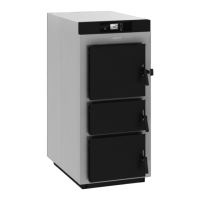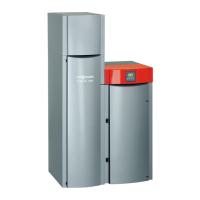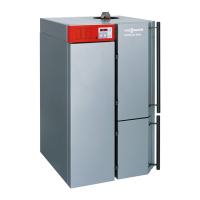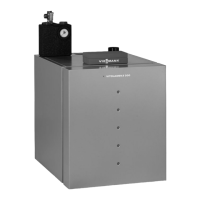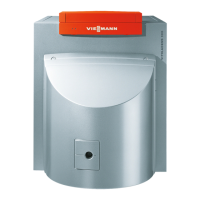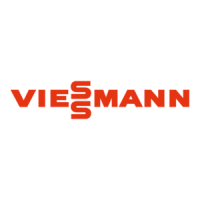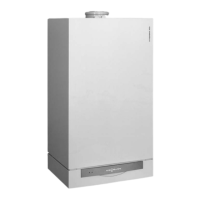Do you have a question about the Viessmann VITOLIGNO 300-S and is the answer not in the manual?
Explanation of symbols used in the manual.
Definitions of key terms used in the manual.
Specifies the appliance's intended purpose and limitations.
Steps and responsibilities for system setup.
Default factory settings for heating and DHW.
Recommendations for efficient operation and cost reduction.
Overview of the boiler's features and components.
Description of the programming unit and its functions.
Describes the different stages of boiler operation after heat-up.
Steps to take before starting the boiler.
Specifies the correct size of logs for the boiler.
Instructions on how to load the boiler with fuel.
Procedure for manually igniting and starting the boiler.
Using the electric ignition system for heat-up.
How and when to add more fuel to the boiler.
Actions to take if the boiler overheats.
Explanation and reset of the STB safety feature.
Information on the safety valve function.
Methods to minimize tar formation in the hopper.
How to move through and use the control unit interface.
Overview of the standard and extended menus.
Demonstrates settings using dialogue lines.
Behavior and activation of the screensaver.
How to define periods for automatic ignition.
Procedure to modify existing ignition time settings.
Adjusting day and night room temperatures and selecting heating circuits.
Setting the heating mode for central heating.
Configuring daily heating schedules and time phases.
Modifying slope and level for optimal room temperature control.
Procedures for putting the central heating into standby.
Adjusting room temperature temporarily for events.
Reducing room temperature for short absences.
Setting a program for extended absences.
Adjusting the domestic hot water temperature.
Setting the operating mode for hot water generation.
Configuring schedules for domestic hot water heating.
Procedures for disabling domestic hot water heating.
Adjusting contrast and brightness of the control unit display.
Customizing names for heating circuits.
Configuring time, date, temperature units, and boiler water temp.
Adjusting residual oxygen and minimum system temp, restoring factory settings.
Accessing system status and operational data via menus.
Retrieving various temperature readings from the system.
Displaying and understanding system error codes.
Steps for safely switching off the heating system for extended periods.
Diagnosing and resolving issues causing insufficient heating.
Diagnosing and resolving issues causing excessive heating.
Troubleshooting problems with domestic hot water supply.
Interpreting system fault and warning indicators.
System inspection, boiler, DHW cylinder, safety valves, and filters.
Table outlining activities based on operating hours and intervals.
Safety precautions and general guidance for maintenance.
Preparations for required emissions tests.
Procedure for cleaning the ash pan and chamber.
Instructions for cleaning the fuel hopper.
Steps to clean the heat exchanger components.
Procedure for emptying the ash pan of the heat exchanger.
How to clean the boiler's sight glass.
Steps to clean the combustion chamber.
Details on fuel constituents, moisture, and storage.
Specifications for logs, woodchips, and joinery waste.
List of fuels that must not be used.
Definitions of technical terms used in the manual.
Guidelines for disposing of packaging and the heating system.
Explanation of symbols used in the manual.
Definitions of key terms used in the manual.
Specifies the appliance's intended purpose and limitations.
Steps and responsibilities for system setup.
Default factory settings for heating and DHW.
Recommendations for efficient operation and cost reduction.
Overview of the boiler's features and components.
Description of the programming unit and its functions.
Describes the different stages of boiler operation after heat-up.
Steps to take before starting the boiler.
Specifies the correct size of logs for the boiler.
Instructions on how to load the boiler with fuel.
Procedure for manually igniting and starting the boiler.
Using the electric ignition system for heat-up.
How and when to add more fuel to the boiler.
Actions to take if the boiler overheats.
Explanation and reset of the STB safety feature.
Information on the safety valve function.
Methods to minimize tar formation in the hopper.
How to move through and use the control unit interface.
Overview of the standard and extended menus.
Demonstrates settings using dialogue lines.
Behavior and activation of the screensaver.
How to define periods for automatic ignition.
Procedure to modify existing ignition time settings.
Adjusting day and night room temperatures and selecting heating circuits.
Setting the heating mode for central heating.
Configuring daily heating schedules and time phases.
Modifying slope and level for optimal room temperature control.
Procedures for putting the central heating into standby.
Adjusting room temperature temporarily for events.
Reducing room temperature for short absences.
Setting a program for extended absences.
Adjusting the domestic hot water temperature.
Setting the operating mode for hot water generation.
Configuring schedules for domestic hot water heating.
Procedures for disabling domestic hot water heating.
Adjusting contrast and brightness of the control unit display.
Customizing names for heating circuits.
Configuring time, date, temperature units, and boiler water temp.
Adjusting residual oxygen and minimum system temp, restoring factory settings.
Accessing system status and operational data via menus.
Retrieving various temperature readings from the system.
Displaying and understanding system error codes.
Steps for safely switching off the heating system for extended periods.
Diagnosing and resolving issues causing insufficient heating.
Diagnosing and resolving issues causing excessive heating.
Troubleshooting problems with domestic hot water supply.
Interpreting system fault and warning indicators.
System inspection, boiler, DHW cylinder, safety valves, and filters.
Table outlining activities based on operating hours and intervals.
Safety precautions and general guidance for maintenance.
Preparations for required emissions tests.
Procedure for cleaning the ash pan and chamber.
Instructions for cleaning the fuel hopper.
Steps to clean the heat exchanger components.
Procedure for emptying the ash pan of the heat exchanger.
How to clean the boiler's sight glass.
Steps to clean the combustion chamber.
Details on fuel constituents, moisture, and storage.
Specifications for logs, woodchips, and joinery waste.
List of fuels that must not be used.
Definitions of technical terms used in the manual.
Guidelines for disposing of packaging and the heating system.
